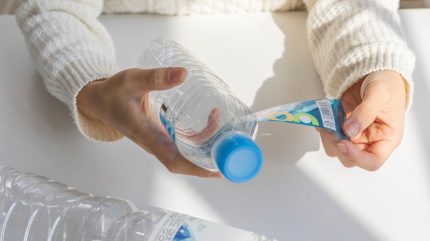
Recycling lines slow or fail for reasons that rarely appear on a brand brief: sleeves that mask polymers, pressure-sensitives that gum up hot-wash tanks, inks that refuse to lift in the pulper.
Get label removal and de-inking right and rPET, rHDPE and recycled fibre quality rises, yields improve and recycled-content targets stop being theoretical.

Discover B2B Marketing That Performs
Combine business intelligence and editorial excellence to reach engaged professionals across 36 leading media platforms.
This playbook focuses on the levers packaging teams control—label films, adhesives, inks, sleeves and tamper features—so bottles, cartons and wraps move cleanly from sort to wash to reprocessing.
Why labels and inks create bottlenecks
Recyclers need predictable behaviour through sortation, washing and de-inking. Poor choices upstream multiply into downtime and downgraded output.
Sorters can’t see what sleeves hide
Full-body sleeves that cover recognition zones confuse near-infrared (NIR) sorters, pushing PET into mixed streams or residue. Dense darks and carbon-black inks worsen mis-IDs. On fibre, heavy laminates or high ink coverage raise rejects at optical stages.
Wash tanks hate sticky surprises
In PET and HDPE recycling, float–sink and hot-caustic washing are standard. If pressure-sensitive adhesives (PSAs) stay tacky, they smear onto flakes and filters; paper labels that turn to mush release fines that blind screens. Label fragments that don’t float off hitch a ride into extrusion, becoming gels and black specks.

US Tariffs are shifting - will you react or anticipate?
Don’t let policy changes catch you off guard. Stay proactive with real-time data and expert analysis.
By GlobalDataDe-inking has limits
Paper mills need ink to detach into coarse, removable particles. Crosslinked UV systems, stubborn pigment packages and greasy residues demand more chemistry and energy. Residual tint or stickies force mills to add virgin fibre or brighteners, raising cost and constraining recycled content in premium grades.
End-product quality takes the hit
Adhesive and ink residues yellow PET, seed fish-eyes in HDPE, and cause specking and breaks on paper machines. The result is lower-value pellets and pulp, and tighter acceptance policies for printed packaging.
Design choices that make removal and de-inking easy
Most fixes cost pennies and save thousands downstream. Specify for separation at real plant conditions, not just lab ideals.
Choose floatable, NIR-friendly label films
For PET/HDPE bottles, specify low-density, floatable label films and sleeves that separate from heavier bottle flakes in hot-caustic wash.
Add tear tabs or perforations and keep print-free windows over recognition zones so NIR still “sees” the base polymer. Where sleeves carry branding, make the sleeve itself NIR-detectable.
Specify wash-off or alkali-release PSAs
Use adhesives designed to lose tack and release cleanly at typical PET/HDPE wash conditions (e.g., 65–85°C, alkaline pH).
For paper, prefer de-inking-friendly adhesives that form coarse particles, not smearing stickies. Put temperature, pH and dwell-time targets on the spec so suppliers formulate to the process, not assumptions.
Pick de-inkable inks and varnishes
Use ink systems validated for standard paper de-inking and plastic hot-wash. Replace carbon-black with detectable black, avoid heavy metallics, and control total coverage—especially near seams and perforations.
Where deep colour is non-negotiable, print on a removable sleeve or label rather than direct-to-bottle.
Keep laminations light and compatible
For cartons and wraps, use dispersion barriers or thin, compatible coatings that break up and wash out. Avoid large continuous plastic films on fibre unless proven necessary; if used, ensure they fragment and don’t create stickies at the pulper.
Make tamper-evidence cooperate
Frangible bands, void labels and induction liners should either stay with the cap or release in the hot-wash. Use liner adhesives that let go in caustic; for many dry goods a land seal plus a tamper band meets performance without extra layers.
Simplify materials where possible
Monomaterial thinking helps yield: PE closures on PE bottles, PP on PP; label films that either match or cleanly separate. Limit label real estate to what branding needs, not habit.
Prove it on the line and keep it that way
Design pays off only if plants experience the gain. A light layer of testing, data and change-control keeps lines flowing.
Run plant-real trials, not paper promises
Test fully finished packs—printed, glued, sleeved—through a partner recycler’s hot-wash and de-inking lines. Measure label release rate, adhesive residue, de-inkability, and clarity/brightness on pellets or sheets. Log odour and filter fouling.
Specify acceptance windows
Agree workable windows rather than single points (e.g., density range for label float, adhesive release at stated pH/temperature, de-inkability index at standard pulper energy). Variability across plants then hurts less.
Close the loop with reprocessors
Share structure details (label film, adhesive family, ink set, weights). Invite feedback on blinding, tank fouling or residue. Small swaps—a different crosslinker, reduced heavy coverage near seams—can lift throughput and quality.
Lock specs to SKUs and artwork
“Spec drift” is a common failure: a regional adhesive switch, a promo sleeve, a late varnish change. Freeze label and ink specs in the materials database; require approvals for substitutions; re-validate after supplier or artwork changes.
Track a short KPI set
For bottles: label release rate, adhesive residue index, NIR sort pass rate, pellet clarity/IV where relevant. For paper: stickies count, post-de-inking brightness, dirt speck area, and machine break rate. Review after seasonal peaks.
Tell users what to do
Short on-pack prompts lift capture and cut contamination: “Peel sleeve via tab. Recycle bottle with cap.” For B2B formats, print removal notes on outers so operatives prep loads correctly.
The takeaway for operators
Label removal that works and de-inking that flows are design problems first, operational problems second.
Specify floatable label films and wash-off PSAs for PET/HDPE; use de-inkable inks and dispersion barriers on fibre; design sleeves and tamper features that cooperate with sorters and hot-wash tanks.
Validate complete packs in real plants, lock specs to artwork, and track a handful of KPIs that matter to reprocessors.
Do this well and you’ll get cleaner flakes, brighter pulp and higher recycled-content rates—without slowing a single conveyor.





